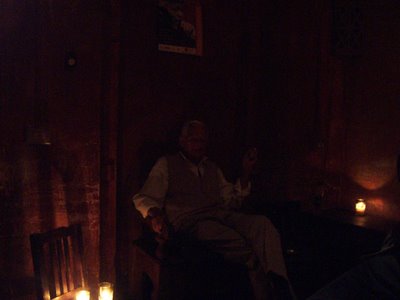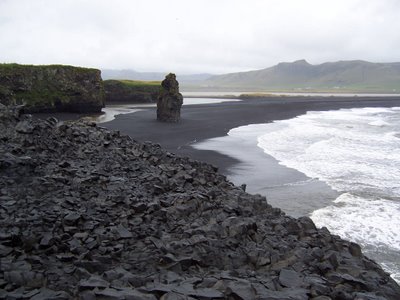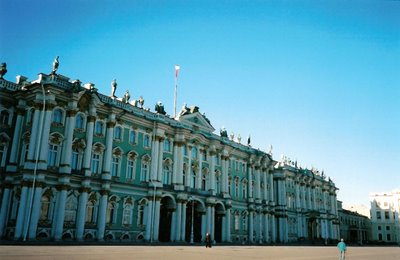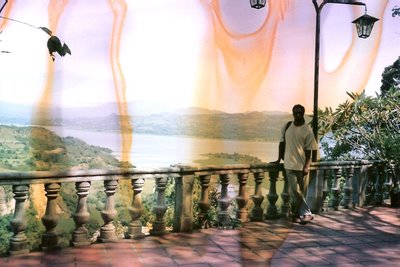2006 Updates & Errata
What a strange 2006 it's been. When the clock strikes midnight and the year turns over, I'm going to toast this way: "To sanity!" And then I'm going to kiss my girlfriend and remember that life is good.
In my post
How to Roast a Pig’s Head I shared a recipe and claimed that you wouldn’t find pig’s head recipes anywhere but on BlackNotBlack. I definitely spoke too soon on that one, because once I actually decided to poke around online I discovered there actually are other recipes. In fact there are quite a few. You can find three of those recipes
here,
here and
here, should you decide that head roasting is your thing. But I daresay none of those recipes come complete with a deity summoning, as mine did, and none of them look as good on a table as mine (below).

In the post
Flags of Our Soccer Hooligans, Part 2, which was about my visit to Iceland during Clint Eastwood’s shoot of Flags of Our Fathers, I discussed how certain Hollywood stars bird-dogged the local girls during their nights out on the town. I mentioned it only to point out the cultural differences between ultra-jaded Hollywood and Reykjavik, which is why I didn’t name names. However a few weeks after my post a certain Hollywood hunk who starred in the film announced his split from one of America’s sweethearts, so I guess it wouldn’t have mattered if I had. But I’m still not going to name names because, though the keywords might give my readerless blog a few more hits, it would be old news. If I was ever going to do it, I should have done it in the original post. Anyway, it isn’t as if you can’t figure it out on your own.
On another note, I also read that America’s Sweetheart alleges her husband used drugs during their marriage. I would think most people’s response to that would be: “No duh.” During my time in Los Angeles I worked at Playboy and South Park, and from those vantage points you can be as much of a Hollywood gadabout as you wish. I never took advantage of those jobs in that sense, but I saw plenty from the fringe and I still find it hard to believe that there are people in the world who don’t understand that drug use is a foregone conclusion in Hollywood. That isn’t to say that everyone does them. But everyone has to function around them with a certain level of tolerance.
Moving along, in my post
The One Right Way, I described a remarkable old guy named Bo (pictured below) who I met in Guatemala, and who died shortly after I left. I mentioned that his friends found a condom and a coupon for a Swedish massage in his pocket. In a way, that encapsulates his essence, but perhaps the story of what happened after his death (which was related to me by a friend who was there) will serve as a better barometer of exactly who he was.
He’d mentioned to several friends at various times that he wanted to have a funeral pyre when he died. You tend to tell your friends things like this when you’re eighty-something. The style of pyre he was imagining is the type where a large pit is dug and the wood is piled atop it, arranged in a sort of scaffold shape. As the wood and the corpse burn, both slowly sink into the pit and are covered afterward with dirt—no muss, no fuss. His friends decided they could actually make this happen, and so they located a truck and bought the hundreds of pounds of wood needed to make sure Bo was reduced mostly to ashes. Finding a locale for the burning was the tricky part, but they made a deal with a landowner who owned a chunk of one of the local volcanoes and was willing to let the event take place there.

Word had already gotten out about Bo’s death, and by the time all the arrangements had been made for the burning hundreds of people had found out about it. This was an unexpected snag, because the entire event needed to occur under police radar. When it became obvious that the size of the gathering could not possibly go unnoticed by authorities the organizers called it off. Instead, they were forced to cremate Bo. They found the only crematorium in Guatemala and later scattered the ashes. So Bo never got his wish. Although he had many friends, most of the people who planned to attend his burning probably were more interested in the spectacle than in Bo. That would have really pissed him off, I’m pretty certain, because he wasn’t a superficial person and didn’t much like them, as far as I could tell. But that’s life, isn’t it? You don’t usually get what you want. Why should your last wishes be any different?
What would Bo have said? It's hard to guess, but I can almost hear a disembodied voice: “What does it matter, my friend—cherchez la femme.”
Moving on, I recieved a query regarding the photographs in my blog, and the answer is yes, I make all the photographs except those in which I appear, and those few which are obviously borrowed from news sources and depict Hugo Chavez, Ralph Arza, Muhammad Yunus, and the Texas bordercam images. I also did not make either the horse photo or the boat photo in the post
A Gift to the Earth. Those were made by my friend El Cubano, a film editor in Hell A who was along on the Iceland trip. He doesn't mind my using them, I'm pretty sure, because he still owes me for almost putting my eye out in Guatemala.
Lastly, in my Hugo Chavez post
Venezuela and Guatemala Stand Down I shared some pre-election poll numbers that showed Chavez would win re-election by a landslide. In the run up to the vote American websites like Yahoo and MSN faithfully reported rightist propaganda about the strength of Chavez’s opposition, and their presumed moral superiority as capitalists. They also printed quotes from Chavez opponents claiming the election was already rigged. Call me crazy, but I learned in school that this is irresponsible journalism. Venezuela was overrun with impartial election observers from all over the world at that time, and they declared the machinery of democracy corruption-free, yet Chavez’s accusers got all the ink.
Of all these reports, the most annoying were those suggesting Chavez was buying votes with his many social programs. The elitist right don’t usually like to so openly trumpet their conviction that they are entitled to more and better than everyone else, but in this instance they opened a window that shone light on the most fetid and murky fathoms of their dark beliefs. Specifically, they said that Chavez promising education and health care money to the poor equated to bribery in exchange for votes, but of course did not mention that they thought it was perfectly kosher to promise tax cuts and entitlements to the rich. As elitist double-standards go, that one pretty much takes the cake, but it’s a central belief of rightists everywhere—particularly in the topsy-turvy bizarro world of U.S. politics.
Whew, got that last rant in under the wire. See y’all in 2007 everyone.
A Gift to the Earth

I got started on an Iceland kick back in October with two posts called Flags of Our Soccer Hooligans,
Part 1 and
Part 2, and now cold weather has me thinking about that country again. One of the things that impressed me about the place is the relationship between the people and the environment. It’s the ideal of a green nation. Admittedly, Icelanders have two built-in advantages—a low growth rate that doesn’t strain their green infrastructure, and abundant natural heat driven by volcanism. But these facts don’t diminish the truth that Icelandic nature is such a raw, overpowering presence that green, peaceful coexistence with it is the only realistic choice.

Looking back over my Iceland photos, the strongest emotions are triggered by images of the landscape. I’ve always understood that the value of nature does not lie in whether it can be observed or exploited. Hailing from Colorado, and seeing that region embark upon a path of self-destruction mislabeled as growth, cannot help but teach that lesson. Don’t get me wrong—people reproduce and they have to live somewhere. But the building of suburban condos without thought to how people will move from home to market and home to job has made miasmic labyrinths of cities. Building a light rail system only after the roads are already jammed to a standstill is folly when those same roads just fifty years earlier had working rail systems which were dismantled. Some cities, such as San Francisco, were farsighted enough to keep their mass transit systems. Now scientific data has caught up with common sense, and we know that green growth is demonstrably profitable.

It may seem impossible to resist the trend toward uncontrolled growth. Growth is good, growth means jobs. But behind the scenes, what growth really means is millions of dollars for ten or twenty men who live in the Caribbean, while the communities they build grapple with traffic, pollution, and high gas prices as their inhabitants struggle to make their way toward distant work places. But to resist growth is anti-American, perhaps even evil. After all, in capitalist societies the market is king, supposedly blessed by God himself, and the word sayeth that even though there be ample room in city centers, it is okay to raze virgin aspen groves to build condos. And it’s also okay to tell gullible buyers they’re purchasing a piece of untamed nature when the plan all along is to pack in a few thousand more homes, two malls, and six Burger Kings.

But there's a radical alternative, which is to question whether a class of people who are destroying the American wilderness—and with G.W. Bush's blessing propose selling national parks for condo development—are worth listening to anymore. In Iceland I saw what a culture looks like when it doesn’t make those disastrous choices. Parts of the country look like Vail, Colorado, before the mountains were stripped bare for quad ski lifts. Other parts look like northern California, before that region became dotted with alpine condos. The Icelandic example is the result of a continual fight against greedy real estate barons who refuse to be told when enough is enough. And that’s the entire point—when green advocates fight back, ultimately compromise and balance is the result. In the U.S. real estate barons are fighting a battle without adversaries.

Wandering around Iceland you start to ask yourself—is there another way? And the answer echoes back to you from the vast snowy landscape—it would be a gift to the Earth.
St. Pete’s Wicked Ways

I recently stumbled across an
article on
Vanity Fair.com written by one of their many editors—Victoria Mather. The article was about St. Petersburg, Russia, and read like jacket copy for a romance novel. Vanity Fair employs some of the most talented English-language writers on the planet, but somehow their travel dispatches are always a little limp. None of them dig deeply, get to the heart of matters. They are content to describe peaceful scenes lit by lamplight and filmed through star filters. In the foreground you see couples kissing chastely under a bridge as boats drift by. Perhaps VF publishes these sorts of stories because their readers are well-heeled boomers whose yen for adventure passed with their last gallstone, or perhaps it’s because the brand is owned by Condé-Nast, travel publishers extraordinaire. But still, for a magazine with VF’s investigative reputation, this travelogue style reporting is a little disappointing.
Russians don’t kiss under bridges much—those places are the domain of black marketeers who sell western goods at a tenth the price charged in the United States. Russians love their nation, but the weakness of their tattered old ruble means their chances of getting ahead are enhanced by a mattressful of dollars or euros. It’s technically illegal to accept them for retail services, so subterfuge is needed. When I was there several years ago I hadn’t yet exchanged my currency when dinnertime came around, so I looked specifically for the magic Visa symbol in restaurant windows. At the restaurant I chose the credit machine was broken—which none of the staffers bothered to mention until after the meal. Clearly this was deliberate.
The waiter faked embarrassment about the mix-up, and then asked, “Would you happen to have dollars, sir?”
Well, it just so happened I did. I reached for them.
“Not here, sir—in the back.”
We retired to a dim corner at the rear of the restaurant. After he twice showed me with a calculator that he was not cheating me, I paid the ruble-tabulated bill with dollars, thus helping stiff the central government of the tax they would collect if there existed an electronic record of the transaction. I felt like I was in a spy movie. And then I realized—in a sense, I was. Being in St. Petersburg was like playing a bit part in a John Frankenheimer film—the role of Oblivious Diner #3, who appears screen right and exits screen left without ever noticing the protagonist and villain at centerscreen swapping a cash-filled briefcase for a microchip.

When capitalism flooded through the cracked Iron Curtain, the Russians who fared best were those ready to embrace true Western vice and rob their brethren blind. An entire gangster elite rose out of Soviet ashes. Pyramid schemes, American porn, and high-grade Amsterdam ecstasy abounded. Beautiful prostitutes paraded openly along the Nevsky Prospect. Electronic piracy made instant millionaires—they drove Jeep Grand Cherokees and Mercedes coupes, and bought boxes at Petrovsky Stadium to cheer on Zenit FC. They were above the law—in the busiest sector of town someone brought to my notice black-on-black Russian Mafia cars parked on the sidewalks, as a meter maid ambled past and instead issued tickets to vehicles sitting at expired meters.
An underground railroad funneled contraband art and artifacts to wealthy Western collectors. Rumors abounded that the State Hermitage Museum (pictured below), one of the largest art repositories in the world, was being looted. This likely had been going on for decades, but the arrival of capitalism made art theft much more lucrative. The museum was supposedly bleeding masterpieces—seemed all you had to do was walk past and a priceless artifact would drop into your arms. Officials were tight-lipped about this for years, but when thieves skated with 221 precious items in July 2006, museum director Mikhail Piotrovsky had no choice but to acknowledge the theft. He said it certainly had been an inside job. Piotrovsky commented: “The presumption of innocence and the atmosphere of absolute trust in curators that has reigned in the museum in the past will have to change. The new economic reality has affected how people think, and money has begun to play a greater role.”
One of the missing artifacts was recovered in August when police received an anonymous call pointing them toward a garbage bin outside a building on Ulitsa Ryleyeva. They arrived to find an icon worth $200,000 sitting in the trash. In art circles the rumor mill revved to overdrive. The Hermitage, which houses more than three million pieces, was simply unable to keep a close watch on the entire horde. Thieves got the message and more heists followed. September 2006—five more works go poof, including a crystal flagon adorned with a crown holding 300 rubies and 24 pearls. December 2006—a female custodian foils yet another theft by grappling with a man who had broken a glass case with his elbow and tried to escape with a valuable ladle. The whole situation seemed right out of the Pink Panther. To be complete the story needed only David Niven climbing the Hermitage using suction cups.

Even the Case of the Irradiated Sushi—now playing on the international stage—connects to St. Petersburg. Italian newspapers reported that Mario Scaramella, a security consultant who has helped Italy's parliament investigate Cold War-era Soviet espionage, met with Alexander Litvinenko that fateful day in London and revealed a hit-list containing both their names. Scaramella says he had a source who told him that the threat came from Mafia-style criminals based in St. Petersburg, possibly acting on behalf of Russian president Vladimir Putin. Scaramella’s source also allegedly implicated the same criminals in the assassination of Russian journalist Anna Politkovskaya in October. This is all pure cloak and dagger. Even the names seem lifted from the pages of a spy novel—Ian Fleming's Man with the Golden Gun was named Scaramanga. Mario Scaramella may well be the man with the golden vial. He was in the best position to season Litvinenko's sushi with polonium-210, and himself had only a glass of water as poor Alexander noshed a meal that would soon send him the way of Marie Curie.

Litvinenko’s death was certainly bizarre, and as such, also quintessentially Russian. Consider: Leo Tolstoy died at a remote rail junction, having renounced his literature and wealth, and adopting the life of a wandering ascetic. Mystery continues to cloud Stalin’s death—stroke, or murder? Leon Trotsky was pickaxed—not icepicked—rather an exotic departure. And speaking of death exotica, Grigory Rapsutin (left) was first poisoned, then shot multiple times, then dumped into the frozen Neva River through a hole in the ice, where he later drowned, or died of exposure after climbing out downriver. Check the firsthand
account of one of the assassins, Stanislaus de Lazovert, as he describes the moments after Rasputin was initially shot: “The others came bounding over to him and stood over his prostrate, writhing body. It was suggested that two more shots be fired to make certain of his death, but one of those present said, ‘No, no; it is his last agony now.’ We left the room to let him die alone, and to plan for his removal and obliteration. Suddenly we heard a strange and unearthly sound behind the huge door that led into the library. The door was slowly pushed open, and there was Rasputin on his hands and knees, the bloody froth gushing from his mouth, his terrible eyes bulging from their sockets. With an amazing strength he sprang toward the door that led into the gardens, wrenched it open and (ran) out.”
Some would say this is the sort of thing travelers don’t really want to read about their destinations, but I disagree. The trend in tourism is toward authenticity and grit. Many people prefer to climb a volcano or kayak the Amazon than be directed to and fro by nametagged tour guides: “Don’t wander back there, sir—that’s off-limits.” A little danger is attractive—like a lover with a dark side. Tales of murder and backstabbing add intrigue to St. Petersburg, a city already far too beautiful to benefit much from the

descriptive powers of bedazzled travel editors. But just for the heck of it, I’ll try my hand at travelogue right now: St. Petersburg is a metropolis of revolutionary monuments, hulking stone museums, and Venetian-style canals. The colors will surprise—the wedding cake palaces and ice cream scoop cathedrals form a Christmas cityscape beneath turbulent clouds that fume and roil in a white sky still sunlit come the stroke of midnight.
Yeah, that was fun, but I like the grit better.
Labels: russia, st. petersburg, travel
Hotel Yang, Part 3
Casting an eye back over my previous Hotel Yangs, it strikes me that readers might think I’m picking on third world countries. Actually, the worst hotels I’ve slept in happen to be located in the U.S. I saw most of these dumps as I roamed back and forth across the continent as a member of a band. It was as I drove a Ford Econoline deathtrap along the American interstates from show to show that the travel bug first bit me, and it’s been siphoning my blood ever since. I’m actually going to discuss an event from one of my band’s tours, an incident when my mates and I became stranded in the central Alabama wilderness on a hot Sunday morning only to be rescued by the hillbillies from Deliverance—but in a later post.

In
Hotel Yang, Part 1, I mentioned El Salvador’s Hotel Happy House and my somewhat unpredictable relationship with the place. That dynamic was never more evident one summer day when my girlfriend Diana and I rolled into town after a particularly arduous and sweaty trip. We got a room, dumped our packs, and lay down for a rest—only to be startled awake by a sound like whale song from the adjacent room.
Diana shot bolt upright and said, “What in the hell was that?”
I’d recognized the sound immediately. I said, “It’s a dog.”
“That’s a dog?”
“It’s a Bassett hound. It’s baying. Basset hounds bay.”
How did I recognize the sound of a Bassett hound? Well, as I said, I’ve been to Alabama, arguably home to more Bassett hounds per capita than any other U.S. state, and I’ve also seen several movies where runaway slaves were chased through swamps by these creatures. The baying continued, rendering the possibility of sleep a futile wish and filling me with a deep, ancestral fear that bad men with whips were coming for me. I climbed from bed, struggled into my jeans, and searched for my shoes—you know the drill—all while this hellish noise continued.
The desk clerk was the same guy from my previous Happy House stays, and I had already decided his unending presence—day and night, weekends and holidays—could only be explained if he was one of three triplets who all worked there. When One-of-Three (or #1, as we’re now going to call him) saw me coming he smiled. By now, you see, we’d settled into a routine—he’d give me a room that had problems, and I’d come back to the desk and ask for a different one. It was like a waltz we’d perfected over a number of my stays there. My Spanish was better each subsequent visit, but never fluent to the extent that #1 couldn’t credibly pretend to have no idea what I was saying.

So I told him there was a loud dog in the adjacent room, and he sort of chuckled and said he wasn’t sure he could do anything about it because the hotel was booked solid. I told him yes he could, that there was surely an empty room he could switch me into, or, regrettably, I’d have to leave (this is usually an effective threat, since the Happy House is an informal place where you pay for your stay when it ends). #1 said all the hotels were booked. I rolled my eyes and said I doubted it. We had both grown to enjoy this game, in some odd, co-dependent fashion. My victory was usually derived from getting what I wanted, and his came from making me work extraordinarily hard in a language I hadn’t yet mastered. This time, though, it was an incredible struggle, and in the back of my head I knew I was being set up for an epic punchline.
Cut to an hour later. Diana and I are in our new room, and we are awakened by yet more howling, but not from the same dog. Again I fumbled with my pants and searched for my shoes. I opened the door and into the room rolled a wave of dog odor so noxious and thick I could have surfed to Nicaragua on it. The entire hotel reeked of dog. #1 was laughing when I came to the desk. He explained—barely containing himself—that there was a dog show at the nearby Hotel Princesa, and the Happy House, as well as every other nearby hotel, was booked up with mutts and mutt-owners for the weekend. His glee in revealing this was so infectious I had to laugh too. Our relationship became something akin to friendship at that point, and every time I stayed there afterward he was glad to see me. I was certainly glad to stay, which is why the Hotel Happy House receives four-and-a-half yangs—good for second place in the rankings.
I had another bizarre hotel incident with an animal, this one in a small colonial town in the Salvadoran highlands not far from the capital. The town is called Suchitoto and it’s a quiet place of picturesque stone houses, shabby little stores, and a couple of very good pupuserias. It’s perched on breathtakingly high cliffs above Lago de Suchitlan (pictured below, in a waterlogged photo). When Diana and I arrived the air was filled with thousands of dragonflies. I hadn’t seen dragonflies since I was a kid, and it was like going back in time to a place so distant and clean I’d almost forgotten about it.

We found a room in a family run hotel called Los Alemdros, a former colonial mansion with a courtyard, lounge, and rooms decorated with local handicrafts. After spending the evening checking out the sights, we returned to the hotel, eventually turned off the lights and went to sleep. Into the silence came what sounded like liquid streaming to the floor. When I turned on the lights there it was, definitely liquid, a sizable puddle of it, freshly pooled between the bed and the door. Usually when I don’t know what something is I stick my finger in it—perhaps not a recommended method of testing, I admit. But good instinct prevailed this time, and instead I got down on hands and knees and smelled it. Yes, it was urine, and it had come through the ceiling. Again came the fumbling with pants and the search for shoes, and again I found myself standing before a less-than-thrilled desk clerk, this one a middle-aged woman who clearly wasn’t going to find any of my complaints charming.
“Hay una problema con el cuarto,” I told her. “Hay un rata en el techo, y”—I fought for the word—“orinado.”
She looked at me like I was crazy. “That wasn’t a rat,” she replied in Spanish. “It was our cat. It doesn’t like strangers and whenever new guests check in it climbs up in the rafters and tries to piss on them.” She delivered this news in a robotic monotone, as if she’d been explaining it to guests for forty years. I was almost afraid to ask for a new room. But I did and she simply shook her head. “He’d just follow you. Anyway, he already missed. You’re safe now.”
The cat only had enough ammo for one shot?
That made zero sense, but by this time I’d learned my lesson. I bade the woman goodnight, went back to the room, put my and Diana’s luggage and clothes in the armoire, and went to sleep. Adapt, adjust—that’s the key to travel. By this point I was indoctrinated enough in Central America not to stress. Anyway, the news that this cat was aiming at us was probably more disturbing to Diana than me—she sleeps on her back with her mouth open.
I’ll conclude this series with Hotel Yang, Part 4, which I’ll use to describe my top ranked yang hotel, a place so decrepit, and so vile, that only a masochist like me could love it.
How to Roast a Pig's Head and Summon a God

Although I have no readers, if by chance you’re lost and somehow stumbled upon this posting, you probably assumed from the title that it was going to be a political rant. Well, no—BlackNotBlack is never going to be about what you think, and today, to your everlasting misfortune, I’m actually going to instruct you how to cook a pig’s head for a party. You won’t find my recipe (or any pig's head recipe, for that matter) in a cookbook or on Food Television, but you really aren’t anyone until you’ve tried it.
First, be forewarned that actually purchasing a pig’s head can be problematic. I don’t know how you’d do it in the States, but I had to search the most nauseating section of my local market to find one. Since it’s just junk meat, the noggin was located beneath thirty or so pounds of lungs, brains and other delicacies, and it took the butcher a long while to remember where he’d left it. After the purchase I had to carry the head across town in a transparent plastic bag as people steered well clear of both me and the blood trail I dribbled.
When I got the head home I looked at it closely and noticed that it possessed some human characteristics. In general, it reminded me of an old redneck. It had nests of ear hair and a stamp on its forehead that looked like a tattoo. I found both of these facts disturbing, anthropomorphically speaking, but luckily a few hours slow roasting in a 350 degree oven cooked the hairs down to crinkly little nubs and obliterated the forehead ink.
Those who have eaten both pig and human say the two meats are remarkably similar. Since I’ve never eaten man (succulent though he may be), I was surprised by the head’s traits. When you cook your pig’s head, try to ignore its human qualities. As for seasoning, this is actually something to consider carefully, because if you think for a moment the guests at your party won’t eat a pig’s head you’re wrong. Dares and bets alone will account for a third of it being devoured.
So here’s my recipe:
1 pig’s head
salt
pepper
ten bulbs garlic
2 limes
olive oil
a cluster of rosemary
Wash head carefully, particularly underneath, where it has been severed, and pat dry. Be extra careful to rinse out nasal cavities, which may contain mucus from the pig's death rattle. Rub the head (but gently) with broken garlic cloves and set these aside. Coat the head lightly with olive oil, then salt and pepper according to personal preference. You can also add garlic salt or lemon pepper if you like, or, if it’s available where you live, that Essence stuff Emeril is always pushing on his tv show. Slice the limes and place inside the pig’s mouth along with the rosemary and the garlic that was set aside. Bake the head at 350 degrees until dark brown, or until the tips of the ears begin to burn. Remove from oven. Let rest for forty minutes and enjoy!



The roasted head will make a good conversation piece at your party and also serve as a sacrifice to the obscure but powerful santería deity Lord Pig, who may choose to appear by mounting the corporeal forms of various partygoers. Don't be frightened by the spastic movements and guttural moans that result—that's just Lord Pig's way. That’s me at left in the white shirt, under the control of Lord Pig. Also pictured is a friend as she is subsequently mounted. An appearance by Lord Pig is always a good omen, although his power to cloud human minds means most of those present will be unable to recount exactly what happened as the night wore on, while the rest will simply be unwilling. However if you're lucky and one guest can keep his wits in the midst of Lord Pig's mindbending presence, one photo may survive (bottom).

The next day, assuming you can walk, you’ll want to dispose of the head's remains. I decided to sacrifice mine to a pack of troublesome wild dogs that had been terrorizing my neck of the woods, but you may find other uses for yours. When all is said and done, hopefully you will agree that a pig’s head, properly roasted, is all you need to take a run-of-the-mill party
and give it that memorable twist people really enjoy. Even vegetarians (the few who aren't emotionally shattered by the sight of Lord Pig) love the arguments they feel compelled to start.
There’s one more small but important part of the recipe I forgot to mention: 6 rolls of toilet paper. You'll need those the next day, as your digestion does its duty.
Labels: guatemala, pig head, santería
Mel, Movies and the Maya
When Mel Gibson’s newest epic Apocalypto appears in my local cinema, I probably won’t see it. Not because Mel may be an anti-semite, but because I never go to the movies. There are too many loudmouths in the theaters for me to enjoy a film. Apocalypto is also subtitled, which means

there's certain to be more than the usual amount of expository crosstalk. Basically, I can’t abide talking in movies. How did I get this way? Well, one of my first journalism jobs was as a film reviewer for a smallish regional magazine. Usually, I saw the movies before they opened, with just a few other journalists in attendance. Once you get used to that kind of crowd, it’s tough to rejoin the chatterbox set.
Apocalypto has been advance screened, often to carefully selected Latino audiences, with the aim of creating a grassroots buzz. The method a film company chooses for its screenings is indicative of boardroom sentiment about the end product. Advance screenings usually mean the company feels alright about the movie. Conversely, opening night screenings mean the studio is worried about response and wants to rake in as much money as possible before bad reviews and bad word of mouth kill the run. So despite the controversy around Gibson, his corporate partners—Touchstone and Icon—feel they have a winner on their hands.
This can’t come as a surprise—Gibson has proven himself an adept filmmaker. Still though, when your track record traps you into epic scale moviemaking, a spectacular flop is inevitable. Kevin Costner proved that twice, with the Postman and Waterworld, and now hardly anyone remembers when he owned the crown Gibson currently wears. But even though the megaflop pitfall is well documented, I don’t think Apocalypto will be Mel’s undoing. The full-length trailer looks good, and he also has legions of fans that trust his vision and know he will deliver what they want to see.
But the main reason the film will succeed is because it’s getting good reviews. Not across the board, but a few important magazines, such as
Rolling Stone,
The Hollywood Reporter, and
Variety have endorsed it. They all make clear that the film is so filled with action, and so violent, and so well shot, that it will prove irresistible for moviegoers. I rarely wish I was still a film reviewer, but this is one of those times. I’d be able to see the movie without paying for it, thus getting a chance to opine from the moral high ground of having not contributed a penny to its success.

But I digress. Here’s the problem I’m having with Apocalypto—it exploits for profit some of the most exploited people in the world. Sadly, most Maya lacked even the opportunity to benefit from the actual filming. Apocalypto purports to take place in what is now Guatemala, but was actually shot in Mexico. This makes sense—a major film production in Guatemala would be difficult to manage, rife with infrastructure concerns, and not easily staffed with experienced hands. It would be like filming a Christmas movie at the North Pole. However, the film dramatizes the Mayan downfall and most of their direct descendants live in Guatemala, yoked by a poverty which is in turn exacerbated by profiteers who extol the virtue of Mayan culture even as they rape it.
Perhaps it’s the kneejerk liberal in me, but none of this sits well. Let me paint a picture of life for the Maya in Guatemala, which I observed firsthand during the years I lived there. While their country promotes them to the world as tourist attractions, and planeloads of tourists indeed arrive each year to pump billions of quetzales into the economy, the Maya serve as mere footservants to the tourist industry and profit comparatively little for their efforts. While it is true that tourists buy Mayan crafts, the money locals earn is chump change compared to what tour companies charge for transportation, hotels charge for rooms, and restaurants charge for meals. All these Guatemalan businessowners devour the same pie, but only a few leave elbow room at the table for the Maya. The rest use tired racist excuses to justify their economic apartheid.
So here is my hope for Apocalypto—that it is such a runaway success that the governments of Mexico and Guatemala are pressured into addressing these concerns. Most of the programs designed to help lift the Maya out of poverty have been created by international NGOs or wealthy foreigners like Mel Gibson. That fact is an indictment of the Mexican and Guatemalan millionaire elite, who are doubtless hoping that any interest in empowering their exploitable countrymen—if it occurs at all—turns out to be yet another briefly fashionable American cause.
















































